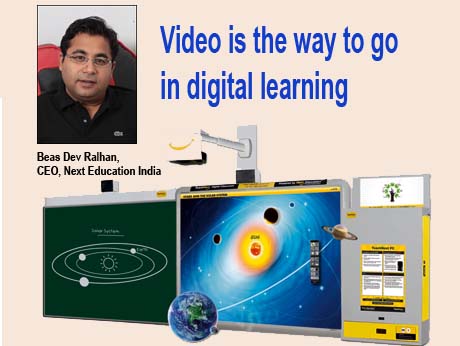
Beas Dev Ralhan, CEO, Next Education India Pvt. Ltd, shares his belief. that video is becoming increasingly important in digitally driven education
The public cloud services market in India is on pace to grow 29.8% in 2014 to total $550 million. Software as a service (SaaS) market will grow at a steady CAGR of 19.5% through 2016. Gartner also predicts that from 2013 through 2017, $4 billion will be spent on cloud services in India & SaaS is the largest overall cloud market segment.|
Use of technology in our everyday lives has become inevitable. The cloud has become a powerful tool not only for all businesses across industries of every size, including small, midsize and enterprise organizations but even for the government sector. This becomes evident with the recently launched cloud computing project ‘MeghRaj’ to accelerate delivery of e-services.
The technology revolution has hugely impacted the education arena too. Cloud-based learning platform for schools enables students to access study content using any device such as tablets and laptops even outside of school. Such activities contribute in broadening a child's thinking process and igniting their curiosity.
The digital trend in the education sector is paving way for technology based solutions in order to revitalize India’s education system. Education delivery, consumption and monitoring is moving onto a digital platform making the future generations competitive at global level. In the current era of convergence, the trend of tablets, net books, laptops and audio-visual equipment to impart knowledge is also catching up.
A recent survey found that video for homework is witnessing unparalleled growth and that mobile computing has no looking back. In addition, students do not use traditional computers to connect to the internet at home and prefer using mobile devices like laptops, tablets etc to plug into the virtual educational space. There has also been a transition in the patterns of internet connectivity. Most students are keen on 3G or 4G enabled devices to connect to the internet or internet-enabled TVs and Wii consoles.
For example, videos are being used to re-create scenes from important pieces of literature to give students a more engaging view of history and the world. Consequently, they are also getting more creative and thoughtful. Besides, the easy-to-use green screen technology is doing wonders.
It allows students to render virtual environments like newsrooms or stages for mock presidential debates / parliament sessions, moulding them into more confident and world-wise adults. These debates or simulated parliament sessions are then webcast so that students from all over the world can interact on the online platform and share views. Apart from making abstract concepts easy-to-understand, these solutions help kids through simulations, activities and standardisation of assessments.
In 2015, video-based learning will continue to transform the primary and secondary education realm. Irrespective of their age, students have the natural ability to understand and, in a very real sense, read visual media. Ground-breaking educators, who have a keen eye on the future, will put in more focus on teaching and encouraging video-based learning.
The higher education space is in a period of great experimentation thanks to the field of online learning. Learning through visual aids today has instilled a healthy desire in students to share quality work in a digital environment and innovative teachers are capitalizing on this medium to help students succeed in an ever-widening digital world.
The education industry is going through a transformation, yet the changes in the system are really slow as compared to the other industries. There are many complex reasons for this slow pace of change, including lack of resources and resistance to new practices. However, the most important obstacles to realizing the potential of digital technology in education are provisions of copyright law concerning the use of educational content, as well as the business and institutional structures shaped by the law.
The solution to these problems lies in understanding the importance of digital learning in this era of tech-savvy parents and children. Focus on the infrastructure and resources to make content available to all so that the authorities are inspired to make amendments in the provisions of the copyright law is also important. These changes can be made only when we understand the significance of e-learning.
January 16 2014
Beas Dev Ralhan is an entrepreneur and investor with a passion for technology-backed business ideas. As CEO, Next Education India, he , overlooks key functions of strategy, product design, technology and operations. He has worked across countries (UK, USA, India, Gibraltar) with multi-cultural, multi-national and multi-lingual teams. An avid open source software movement enthusiast, he is a management graduate from London Business School.